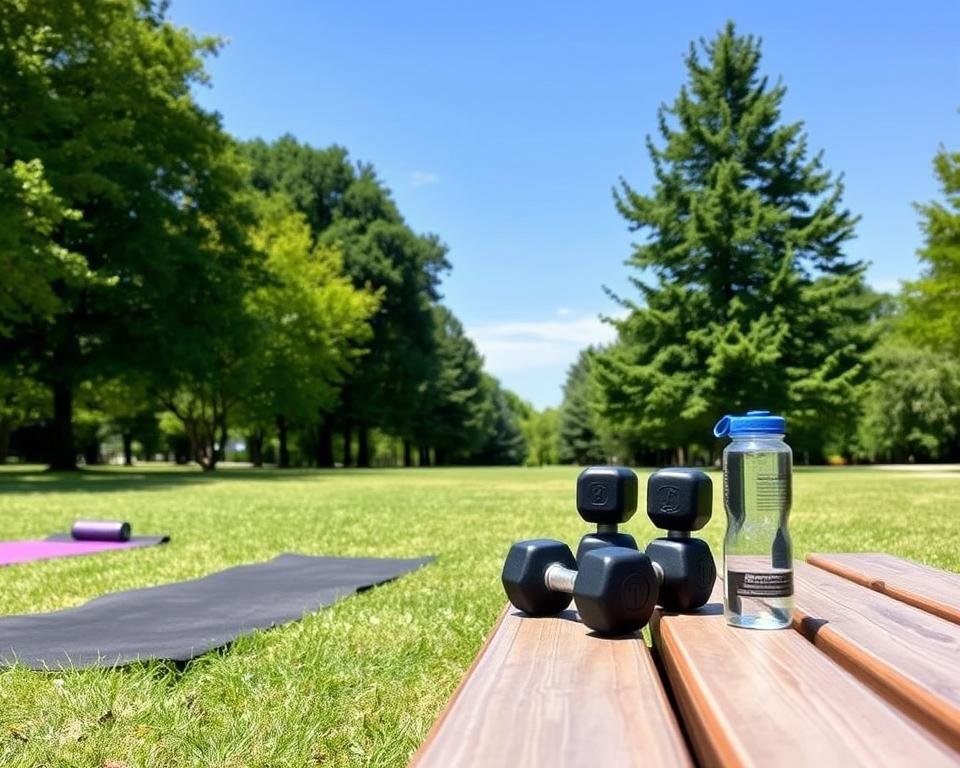Finding ways to stay consistent with exercise is essential for reaching fitness goals. This guide will show you how to build lasting exercise habits. We’ll also help you overcome challenges and make physical activity a daily part of your life.
Whether you’re starting out or need to boost your fitness journey, we’ve got you covered. Our step-by-step guide will give you the tools to make exercise a lasting part of your routine.
Being consistent is the key to a successful exercise program. A regular workout routine can bring many benefits, like more energy, better sleep, and improved well-being. In this guide, we’ll share strategies to help you workout consistently and make exercise a lifelong habit.
Overcoming Obstacles to Exercising
Many people struggle to start a regular exercise routine. Lack of motivation and a busy schedule are common hurdles. We’ll look at common excuses and offer ways to beat them.
Excuses for Not Exercising and Their Solutions
Time is a big obstacle for many, with 50% saying they don’t have enough. Find three 30-minute slots in your day for exercise. Activities like walking or jogging can fit easily into your schedule. Seeing workouts as important appointments helps keep you on track.
Exercise boredom affects about 65% of people. Mix up your routine to stay interested. Joining a group or class can also make exercise more enjoyable and beneficial.
Fatigue is a problem for nearly 40% of people. Start with short workouts to boost energy with endorphins. Choose the best time of day for your workouts to feel more energized.

For over 30%, gyms are too far or inconvenient. Look for home workouts or outdoor activities. If gym equipment is a problem, try introductory sessions or personal training.
Joint pain and childcare stop some people from exercising. Up to 35% face joint pain, and 25% of parents struggle with childcare. Choose low-impact exercises and strength training for joint relief. Use gyms with childcare or exercise with your kids.
Be kind to yourself and enjoy your workouts. Even a little exercise can improve your mood and energy.
How Much Exercise Do You Need?
Finding the right balance in exercise is important. The United States Department of Health and Human Services suggests adults aim for 150 to 300 minutes of moderate exercise or 75 to 150 minutes of vigorous activity weekly. This can include activities like brisk walking, biking, swimming, and high-intensity interval training.
Intensity Levels and Guidelines
Moderate exercises like gardening, water aerobics, and dancing are great for beginners. More vigorous activities, such as running, martial arts, and heavy weightlifting, offer a bigger challenge. Fitness apps can help track your progress and keep you motivated.
Using affordable and convenient resources like community wellness programs or simply going for a walk can make exercise easy to fit into your routine. Consistency is key to enjoying the benefits of exercise. These benefits include a lower risk of heart disease, type 2 diabetes, and certain cancers. Exercise also improves mood, sleep quality, and cognitive function.
By mixing aerobic, strength, and flexibility exercises that match your fitness level and preferences, you can get the most out of your workouts. This way, you can reach your health and wellness goals.
Getting Started Safely
Starting an exercise routine is an exciting step towards a healthier lifestyle. But, it’s important to be careful. Whether you’re new to exercise or coming back after a break, taking the right precautions is key. This helps you avoid injury and sets you up for long-term success.
Before starting your fitness journey, it’s wise to talk to a healthcare professional. They can help you start safely, considering any health conditions or limitations. This medical check can boost your confidence to start your workout without risks.
Warming up and cooling down are vital for a safe exercise routine. They help increase your heart rate and stretch your muscles before and after. This improves your performance, lowers injury risk, and aids in recovery. Remember to stay hydrated during your workouts for optimal health and performance.
As you get better, listen to your body and adjust your workout intensity and length. Don’t push too hard, too fast, as it can lead to burnout or injury. Start safely and gradually increase the intensity to build a fun and sustainable fitness routine that supports your well-being.

Consistent Exercise
How to Make Exercise a Habit That Sticks
Turning exercise into a lasting habit is key for regular physical activity. Studies show that daily exercise is better for forming habits than occasional workouts. Start with 20 minutes and gradually increase the intensity and time to make it a habit.
Experts recommend a 30-day challenge to solidify an exercise routine. This period helps the brain link exercise with pleasure and energy, boosting motivation. Having your gear ready and not overthinking it can also help you start working out.
Studies say it takes about 66 days to form a new habit, ranging from 18 to 254 days for each person. Adding rest days and changing your routine can prevent boredom. Staying consistent is key to forming a successful habit.
To keep exercise a habit, focus on feeling good and having more energy. Set realistic goals and don’t get discouraged by slip-ups. Comparing yourself to others or exercising with a friend can also keep you motivated.
How to Stay Consistent with Working Out
Staying consistent with your workout routine is key to staying healthy. It’s not always easy, but there are ways to keep going. By trying new things, tracking your progress, and staying motivated, you can beat the odds and keep exercising for life.
One great way to stay consistent is to mix up your workouts. Choose activities you genuinely enjoy to make sure you have time for them. Doing the same thing every day can get boring and lead to quitting. By trying new things, you keep your workouts interesting and fun.
“Doing a variety of activities prevents falling into a workout rut and quitting.”
Another good strategy is to blend your workouts with daily activities. Integrate exercise into your routine to make it a natural part of your day. This could be a brisk walk during lunch or some strength training while watching TV. Adding movement to your daily life helps keep your workout routine going.
Lastly, having a supportive network is very important. Having a workout buddy or joining a fitness group can give you motivation and accountability. It also helps to set reminders or rewards for reaching your exercise goals. This keeps you on track and helps you stick with your workout routine.
Consistent Exercise
In today’s fast-paced world, finding the time and motivation to engage in consistent exercise can often feel like a daunting task. However, establishing a regular workout routine is essential not only for physical health but also for mental well-being. To reap the benefits of a fitter lifestyle, understanding how to stay consistent with exercise is crucial. It involves not just a commitment to the activity itself but also a holistic approach that aligns with individual schedules and personal goals.
One effective strategy for maintaining consistency in working out is to establish a set schedule. By treating exercise like any other important appointment, it becomes a non-negotiable part of daily life. Whether it’s early in the morning or after work, carving out a specific time helps to create a routine that supports adherence. Furthermore, setting realistic and achievable goals can significantly bolster motivation; starting small allows for gradual integration into everyday activities without overwhelming the individual.
In addition to scheduling, finding enjoyment in exercise plays a vital role in staying consistent. Engaging in activities that spark joy not only makes working out feel less like a chore but also encourages a longer commitment. Mixing up routines, trying new classes, or exploring different outdoor activities can keep the experience fresh and exciting. Additionally, joining a community or finding a workout buddy can provide accountability, making the journey to consistent exercise feel less isolating and more enjoyable.
Lastly, it is essential to listen to one’s body and understand the importance of flexibility in a workout regime. Life can be unpredictable, and being adaptable allows for a more sustainable approach to fitness. If a session is missed, instead of feeling discouraged, refocusing on progress and celebrating small victories can foster resilience. By implementing these strategies, anyone can learn how to stay consistent with working out, ultimately leading to a healthier, more balanced lifestyle.
Tips to Stay Motivated
Keeping motivated is key to sticking with your exercise plan. You can mix up your workouts and track your progress to stay excited about fitness. These strategies help keep you engaged and motivated on your fitness journey.
Mixing It Up and Tracking Progress
Adding variety to your workouts can stop boredom and keep you motivated. Try new exercises or activities to challenge yourself and keep things fun. Seeing others’ success on social media or with a workout buddy can also boost your motivation.
Positive self-talk, using second-person language, can make you perform better and stay committed. Keeping a workout journal or using fitness apps helps you see your progress. This can motivate you to keep going on your fitness path.
Having a workout buddy who seems fitter can make you want to exercise more. Being around people who are active can really influence your exercise habits.
“Seeing others’ running performance, whether on fitness apps or social media, has been proven to enhance the desire to perform better.”
Setting up a home gym can make it easier to exercise. It removes the need to travel or worry about time. Regular check-ins help you see how you’re doing and adjust your plan. This keeps you motivated and on track.
Conclusion
Getting consistent with workouts is a journey worth taking. This guide has given you tools to beat obstacles and keep exercising. Start small, be gentle with yourself, and pick activities you love.
With hard work and a positive attitude, you’ll see many benefits. Regular exercise boosts your health and mood. It keeps you active for many years.
Recap of consistent workout tips: Set achievable goals, plan your workouts, and get a workout buddy. Try new things and celebrate your wins. Being consistent leads to lasting fitness gains and better health.
Stay focused and upbeat. Enjoy the path to a healthier, more active life.
The path to regular workouts has its hurdles, but the benefits are huge. You’ll look and feel great, have more energy, less stress, and a better mood. Embrace the journey, lean on your friends, and believe in yourself.
With time and effort, you’ll make exercise a big part of your life. It will become second nature.




Pingback: How Much to Feed Your Dog: 1500 calories a day dog
Pingback: 7 Tips for Lung Health: Breathe Better Every Day
Pingback: 30-Day Carnivore Diet Meal Plan: Ultimate Guide